Authors
Marie Besson, Alain Matthey, Youssef Daali, Antoine Poncet, Pascal Vuillemier, Michele Curatolo, Hanns Ulrich Zeilhofer, Jules Desmeules
Lab
University Hospital of Geneva, Geneva, Switzerland
Journal
Pain
Abstract
Positive allosteric modulators of GABAA receptors (GAMs) acting at specific subtypes of GABAA receptors effectively restore compromised spinal pain control in rodents. Studies addressing a similar antihyperalgesic effect in humans are sparse and are hampered by sedative effects of nonselective GAMs available for use in humans. We present results from a randomized controlled double-blind crossover study in 25 healthy volunteers, which addressed potential antihyperalgesic actions of clobazam (CBZ) and clonazepam (CLN) at mildly sedating equianticonvulsive doses. Clobazam was chosen because of its relatively low sedative properties and CLN because of its use in neuropathic pain. Tolterodine (TLT) was used as an active placebo. The primary outcome parameter was a change in the area of cutaneous UVB irradiation-induced secondary hyperalgesia (ASH), which was monitored for 8 hours after drug application. Sedative effects were assessed in parallel to antihyperalgesia. Compared with TLT, recovery from hyperalgesia was significantly faster in the CBZ and CLN groups (P = 0.009). At the time point of maximum effect, the rate of recovery from hyperalgesia was accelerated by CBZ and CLN, relative to placebo by 15.7% (95% confidence interval [CI] 0.8-30.5), P = 0.040, and 28.6% (95% CI 4.5-52.6), P = 0.022, respectively. Active compounds induced stronger sedation than placebo, but these differences disappeared 8 hours after drug application. We demonstrate here that GAMs effectively reduce central sensitization in healthy volunteers. These results provide proof-of-principle evidence supporting efficacy of GAMs as antihyperalgesic agents in humans and should stimulate further research on compounds with improved subtype specificity.
BIOSEB Instruments Used:
Electronic Von Frey 4 (BIO-EVF4),Electronic Von Frey 5 with embedded camera (BIO-EVF5)

 Pain - Thermal Allodynia / Hyperalgesia
Pain - Thermal Allodynia / Hyperalgesia Pain - Spontaneous Pain - Postural Deficit
Pain - Spontaneous Pain - Postural Deficit Pain - Mechanical Allodynia / Hyperalgesia
Pain - Mechanical Allodynia / Hyperalgesia Learning/Memory - Attention - Addiction
Learning/Memory - Attention - Addiction Physiology & Respiratory Research
Physiology & Respiratory Research
 Pain
Pain Central Nervous System (CNS)
Central Nervous System (CNS) Neurodegeneration
Neurodegeneration Sensory system
Sensory system Motor control
Motor control Mood Disorders
Mood Disorders Other disorders
Other disorders Muscular system
Muscular system Joints
Joints Metabolism
Metabolism Cross-disciplinary subjects
Cross-disciplinary subjects Preclinical studies and opioids: role in crisis management in the United States
Preclinical studies and opioids: role in crisis management in the United States 
